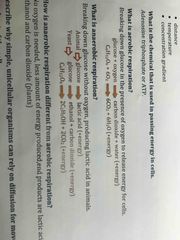![]()
![]()
![]()
Use LEFT and RIGHT arrow keys to navigate between flashcards;
Use UP and DOWN arrow keys to flip the card;
H to show hint;
A reads text to speech;
22 Cards in this Set
- Front
- Back
- 3rd side (hint)
|
State the characteristics of living things. |
4RMECG Require nutrition Respire Reproduce Respond to stimuli(surroundings) Movement Excretion Control of internal conditions Grow and develop |
4RMECG |
|
|
Describe the level of organization in organisms |
Organelles, cells , tissues ,organs , systems |
|
|
|
Describe the function of nucleus |
It contains chromosomes which carry genes. It controls activities of the cell. |
|
|
|
Describe the function of cytoplasm |
It is a jelly like material where chemical reactions take place. |
|
|
|
Describe the function of cell membrane |
It is the boundary between the cytoplasm of the cell and outside. It is partially permeable and controls the movement of some substances. |
|
|
|
Describe the function of cell wall |
It gives support and prevents the plant cell from bursting |
|
|
|
Describe the function of mitochondria. |
Respiration takes place in them and they release energy. |
|
|
|
Describe the function of chloroplast |
They absorb light energy to make food in the process of photosynthesis. |
|
|
|
Describe the function of ribosomes |
Proteins are assembled in them. |
|
|
|
Describe the function of vacuole |
It contains a watery liquid called cell sap which stores dissolved sugars, minerals ions and other solutes |
|
|
|
Describe the similarities in the structure of plant and animal cells. |
They both contain : Cytoplasm Cell membrane Nucleus Mitochondria |
|
|
|
Describe the differences in the structure of plant and animal cells |
Only plant cells have Central vacuole Chloroplasts Cell wall |
|
|
|
Explain the importance in cell differentiation in the development of specialized cells |
Cells become specialized to carry out particular roles. |
|
|
|
What are stem cells? |
Cells that have the ability to divide many times by mitosis while remaining undifferentiated. Later it can differentiate into specialized cells. |
|
|
|
Understand the advantages and disadvantages of using stem cells in medicine |
Advantages: They are used to treat or prevent a disease, or to repair damaged tissues. It is called stem cell therapy.
Disadvantages: Many people object morally to using stem cells from embryo for medical purposes |
|
|
|
Define diffusion |
It is the net movement of particle from a region of high concentration to a region of low concentration. |
|
|
|
Define osmosis |
It is the net movement of water from a dilute solution to a more concentrated solution across a partially permeable membrane |
|
|
|
Describe the factors affecting rate of movement of substances into and out of the cells |
SA/V distance Temperature Concentration gradient |
|
|
|
What is the chemical that is used in passing energy in cells? |
Adenosine triphosphate (ATP) |
|
|
|
What is aerobic and anaerobic respiration? |

Breaking down glucose in the presence of oxygen to release energy for the cells |
|
|
|
How is anaerobic respiration different from aerobic respiration? |
No oxygen is needed, less amount of energy produced, end products are lactic acid( animals ) and ethanol and carbon dioxide ( plants) |
|
|
|
Describe why simple, unicellular organisms can rely on diffusion for movement of substance in and out of the cell. |
They have larger surface area to volume ratio than large multicellular organisms |
|

